Is graduate unemployment rate really 47%?
A British Council sponsored report on graduate unemployment in South Asia, published earlier this, year has generated a media storm in Bangladesh. Prepared by the Economist Intelligence Unit (EIU), the report ranks Bangladesh above India, Pakistan, Sri Lanka and Nepal in terms of employability of local graduates. As per estimates presented in the report, nearly 5 out of every 10 graduates in Bangladesh are unemployed (against 3 out of 10 in India and Pakistan). The report partly attributes graduate unemployment problem to the region's fast expanding but poor quality private education sector and use of outdated curriculum in public universities.
Graduate unemployment is not unique to countries like Bangladesh. Japan has for many years suffered from rising graduate unemployment. In South Korea, a country with very high university enrolment rate, the number of economically inactive graduates is over 3 million. In Singapore, graduate unemployment rate was reported to be 3.6% in 2013 against the average unemployment rate of around 2%. However, the EIU-BC estimate of 47% against Bangladesh's overall unemployment rate of 5% is extremely worrying. As a matter of fact, a graduate unemployment figure nearly 10 times our overall unemployment rate puts the credibility of all Bangladeshi universities on the line.
The EIU-BC report does not add any caveat on the accuracy of the country estimates reported though it does warn the reader against country comparison. A footnote clarifies that “inconsistency in definitions across national sources means figures between countries may not be directly comparable.” However, this warning is not helpful when the actual definition of unemployment and data sources used is not disclosed for Bangladesh and other South Asian countries.
The figures for Bangladesh are puzzling for several reasons. First, the overall reported unemployment rate in Bangladesh is lower (5%) than that for India and Pakistan (8.5% and 6%). How likely is it that graduates have disproportionately high unemployment rate compared to their peers who seek jobs in economies with higher overall unemployment rates? Second, given that the overall macroeconomic conditions and GDP growth rate in Bangladesh have been favourable relative to India and Pakistan in recent years (particularly 2012 onwards), the estimated graduate unemployment rate appears questionable. Third, compared to a decade ago, the labour market and overall economic conditions of Bangladesh have been relatively more favourable to job seeking graduates. This again makes it hard to conceive that every 1 out of every 2 Bangladeshi graduates remains unemployed.
As a matter of fact, for a number of reasons which the EIU-BC report does not acknowledge, the unemployment estimate of 47% is likely to be wide off the mark. First, how we define unemployment matters for the estimate of unemployment rate obtained. Measuring unemployment is notoriously difficult in a developing country context, a point that didn't get a mention in the EIU-BC report. Estimates vary depending on whether the person was unemployed over the last 7 days or 12 months. In South Asia, the task gets more complicated because most women, including female graduates, usually don't seek paid jobs. Upon graduation, they settle down into family life. In case of Bangladesh, only 35% females of working-age population participate in the labour market. Among those who decide to work, many do without pay under informal arrangements. In other words, female graduates are disproportionately out of the labour market and don't enter the calculation of unemployment rate. Any approximation that counts out-of-the-labour-force females as unemployed will hugely overestimate the graduate unemployment rate.
Second, high graduate unemployment is a problem if instead of a temporary blip it reflects a chronic oversupply of graduates. The decade of 2000-2010 has seen tertiary enrolment rate in Bangladesh jump from 5% to 13%. Even then, compared to other countries of similar per capita income, Bangladeshi youths, particularly females, are far behind in terms of university enrolment rate. Therefore, the jury is still out on whether the country is suffering from an excess supply of graduates. Third, measuring graduate unemployment is even harder because many graduates continue in education for a second degree or consider setting up own businesses, which can take time. Even among those who finish higher education, a large proportion may choose to be unemployed to search and accept a job offer if and only if it satisfies their expectations. This sub-population, voluntarily unemployed graduates, is often left out when calculating graduate unemployment rate. Unemployment measure can also vary depending on whether we're considering a recent cohort of graduates or all graduates in the labour market. For these reasons, the standard practice is to rely on a population of graduates for whom the employment destinations are known. Yet this standard has been comprised by the EIU-BC report.
Bangladeshis are right to worry about the poor state of the country's education sector. After all, none of Bangladesh's newly set up public universities and 70 private universities appear in any of the existing global rankings of universities around the world. Instead, most of these universities are frequently in the news for various irregularities, acts of student violence and governance related problems. Therefore, we should critically assess employment prospect of students graduating from these universities and welcome comparative analysis on the actual performance of Bangladeshi universities. However, such analysis must be transparent and based on numbers and estimates we can trust. When grounded in questionable statistics, expert analysis can cause more harm than good.
The writer is a Professor of Development Economics at Malaya University, Kuala Lumpur, and a Fellow of the Royal Society of Arts (RSA). E-mail: [email protected]

 For all latest news, follow The Daily Star's Google News channel.
For all latest news, follow The Daily Star's Google News channel. 



Comments